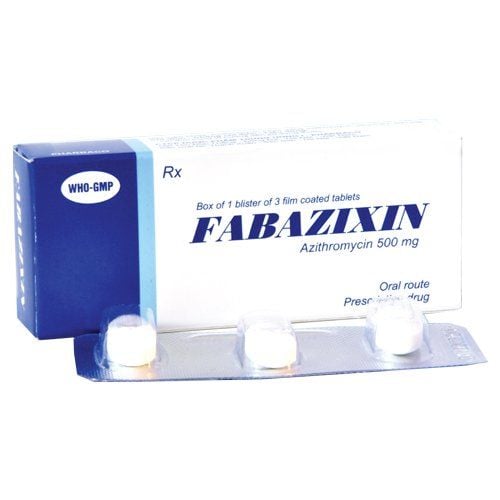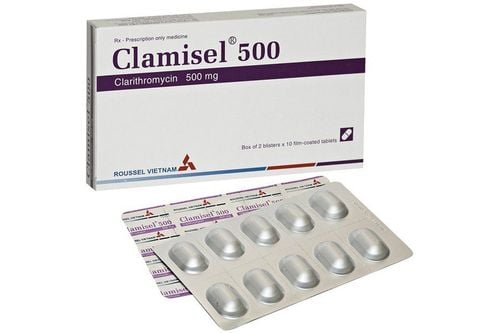This is an automatically translated article.
Neazi 500mg belongs to the group of anti-parasitic, anti-infective, anti-viral - fungal drugs, used to treat infections of the lower and upper respiratory tract, skin or sexually transmitted diseases.1. What is Neazi 500mg?
Neazi medicine 500mg has the active ingredient Azithromycin 500mg, prepared in the form of Azithromycin dihydrate and other excipients, just enough for 1 tablet. Neazi is prepared for human consumption in the form of film-coated tablets, packaged in boxes, each containing only one blister x 3 tablets.
2. Effects of Neazi 500mg
With the main ingredient is Azithromycin belonging to the group of Macrolide antibiotics with bacteriostatic activity at low concentrations and the ability to kill bacteria, fungi, and viruses at high concentrations against some selected strains in urinary tract infections. lower respiratory tract, upper respiratory tract, skin infections and sexually transmitted diseases.Mechanism of action of the drug: Active ingredient Azithromycin inhibits protein synthesis by binding to submolecular structures of Ribosome 50S.
Neazi medicine 500mg is indicated for the treatment of bacterial infections for the following sensitive cases:
People with tonsillitis, pharyngitis; People with otitis media, acute sinusitis; People with acute exacerbations of chronic bronchitis; People with mild to moderate skin and soft tissue infections such as: folliculitis, erysipelas, cellulitis; People with community-acquired pneumonia from mild to moderate; People with cervical and urethral infections caused by Chlamydia trachomati do not appear complications. Neazi 500mg is contraindicated in the following cases:
In case of allergy or hypersensitivity to any ingredient in the drug; Users with hypersensitivity to the active ingredient Erythromycin or any antibiotics such as Macrolid, Ketolid,...; Patients with a history of cholestatic jaundice, liver failure or a history related to previous use of Azithromycin.
3. How to use and dose Neazi 500mg
Usage:
Neazi 500mg is used orally. Patients should take the drug with a sufficient amount of water, do not break, chew or crush the tablet while taking it. The drug can be used near or far from a meal. Users should adhere to the correct dosage and time of use as prescribed by the treating doctor to achieve quick results. For adults, children and adolescents weighing 45kg or more:
Usual indications: 500mg/time/day for 3 days with a total dose of 1500mg or use an alternate course: first day first use a dose of 500mg and continue for 4 more days with a single dose of 250mg/day; Indications for the treatment of cervicitis, urethritis caused by Chlamydia trachomatis infection without complications: Single dose 1g. For the elderly:
Dosage does not need to be adjusted. However, elderly patients are more susceptible to torsades de pointes arrhythmias than other subjects, so care should be taken when using them. For children and adolescents weighing less than 45kg:
Neazi drugs in the form of tablets are not used for this group of people, for treatment should choose other dosage forms to be more suitable. For patients with renal impairment:
No dosage adjustment is required for patients with mild to moderate renal impairment, when GFR 10-80ml/min. In case of patients with severe renal failure, when the GFR is less than or equal to 10ml/min, it should be used with caution. For patients with impaired liver function:
No dose reduction is required for mild to moderate hepatic impairment. Note: Users should only refer to the above dosage. The specific dose depends on the condition and the progress of the disease in each person. To get the right dose, the patient should consult the treating doctor or medical professional.
Treatment in case of missed dose/overdose of Neazi 500mg:
In case of missed dose: If the user forgets a dose and is far from the next dose, the missed dose should be added. If it is almost time for the next dose, skip the missed dose and take the next dose as scheduled. Patients should not arbitrarily take a double dose to supplement the missed dose. In case of overdose: When using an overdose of Neazi 500mg, users may experience some symptoms such as hearing loss, diarrhea, nausea and vomiting. Users need to calm down and immediately notify the doctor for timely advice and treatment. If more serious symptoms appear, users need to immediately go to the nearest medical center for timely treatment. Gastric lavage can be used in combination with supportive treatment.
4. Unwanted side effects of Neazi 500mg
Like almost all other drugs, users of Neazi 500mg may also experience some unwanted effects such as:
Common cases:
Digestive system effects: Abdominal pain, diarrhea , nausea, vomiting. Rare cases:
Fatigue, headache, dizziness, drowsiness; Causes flatulence, indigestion, loss of appetite; Skin itching, rash; Some other side effects such as: Cervicitis, vaginitis,... Rare cases:
Causes anaphylactic reactions; Causes vascular edema; Liver enzymes Transaminase elevated; Causes a transient decrease in neutrophils. Note: When the user experiences one of the above side effects, it is necessary to stop the drug immediately and notify the treating doctor or go to the nearest medical facility for timely treatment.
5. Neazi drug interactions 500mg
Some interactions with Neazi 500mg that users need to be aware of:
With ergot derivatives: Do not use the active ingredient Azithromycin with ergot derivatives at the same time because it has the potential to poison the derivatives. ergo; With antacids: In case of necessity, Azithromycin should only be taken at least 1 or 2 hours after taking antacids; With Carbamazepine: Pharmacokinetic studies in healthy volunteers showed no significant effects on the plasma concentrations of Carbamazepines or their metabolites; With Cimetidine: If taking a dose of Cimetidine 2 hours before using Azithromycin, the pharmacokinetics of Azithromycin are not affected; Cyclosporin: There are some antibiotics of the Macrolide group that will interfere with the metabolism of Cyclosporin, so users need to monitor their levels to adjust the dose of Cyclosporin accordingly; With Digoxin: For some patients, Azithromycin may affect the metabolism of digoxin in the intestine. Therefore, when using these 2 drugs simultaneously, users need to monitor digoxin levels because it has the potential to increase digoxin levels; With Methylprednisolone: Studies in healthy volunteers have demonstrated that Azithromycin has no significant effect on the pharmacokinetics of methylLprednisoLon; With Theophylline: No effect on the pharmacokinetics has been reported when Azithromycin and Theophylline are used together, but theophylline concentration should still be monitored when these two drugs are used together; With Warfarin: There have been no reports on the effect of Azithromycin on the anticoagulant effect of Warfarin. Users can use these 2 drugs at the same time, but still need to monitor blood clotting time.
6. Some notes when using Neazi 500mg
Neazi 500mg drug is not used for outpatient treatment for moderate and severe pneumonia or patients at risk of hospital-acquired infections, immunocompromised. These cases require hospital treatment; Absolutely do not use this drug for people with liver diseases, because the drug is mainly eliminated through the liver; Use in people with compromised renal function (creatinine clearance less than 10ml/min) need to be very cautious and regularly monitored; Need to be careful when using Neazi 500mg for people with heart disease, because there are very rare cases when using the drug with arrhythmia, QT prolongation, ventricular tachycardia, torsades de pointes; The drug contains the active ingredient lactose, so it should not be used in patients with hereditary galactose intolerance, glucose-galactose malabsorption or Lapp lactase deficiency; Be careful when driving and operating machinery, the drug can cause headaches, dizziness, drowsiness; Pregnancy: There are no adequate and well-controlled data in pregnant women. However, because the safety of Azithromycin in pregnancy is uncertain, Azithromycin should be used during pregnancy only if clearly needed. Lactation: The drug has been reported to be excreted in human milk, but there are no adequate and well-controlled clinical studies in lactating women regarding its pharmacological properties. Kinetics of Azithromycin excretion in breast milk. However, breastfeeding should still be stopped during treatment with Azithromycin to ensure the safety of the baby. It is recommended not to breastfeed after 2 days and to continue breastfeeding after that. Notes on how to store the medicine: The medicine should be stored at room temperature with the temperature below 30 degrees and the humidity not exceeding 70%. Medicines should be kept in a glass cabinet, out of the reach of children.
Hopefully, the information shared about the uses, usage and some necessary notes of Neazi 500 will help patients use the drug safely and effectively.
Please dial HOTLINE for more information or register for an appointment HERE. Download MyVinmec app to make appointments faster and to manage your bookings easily.













